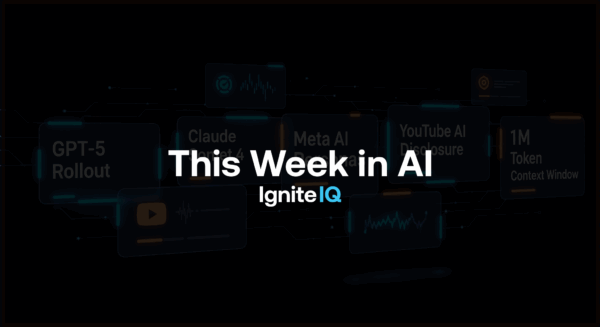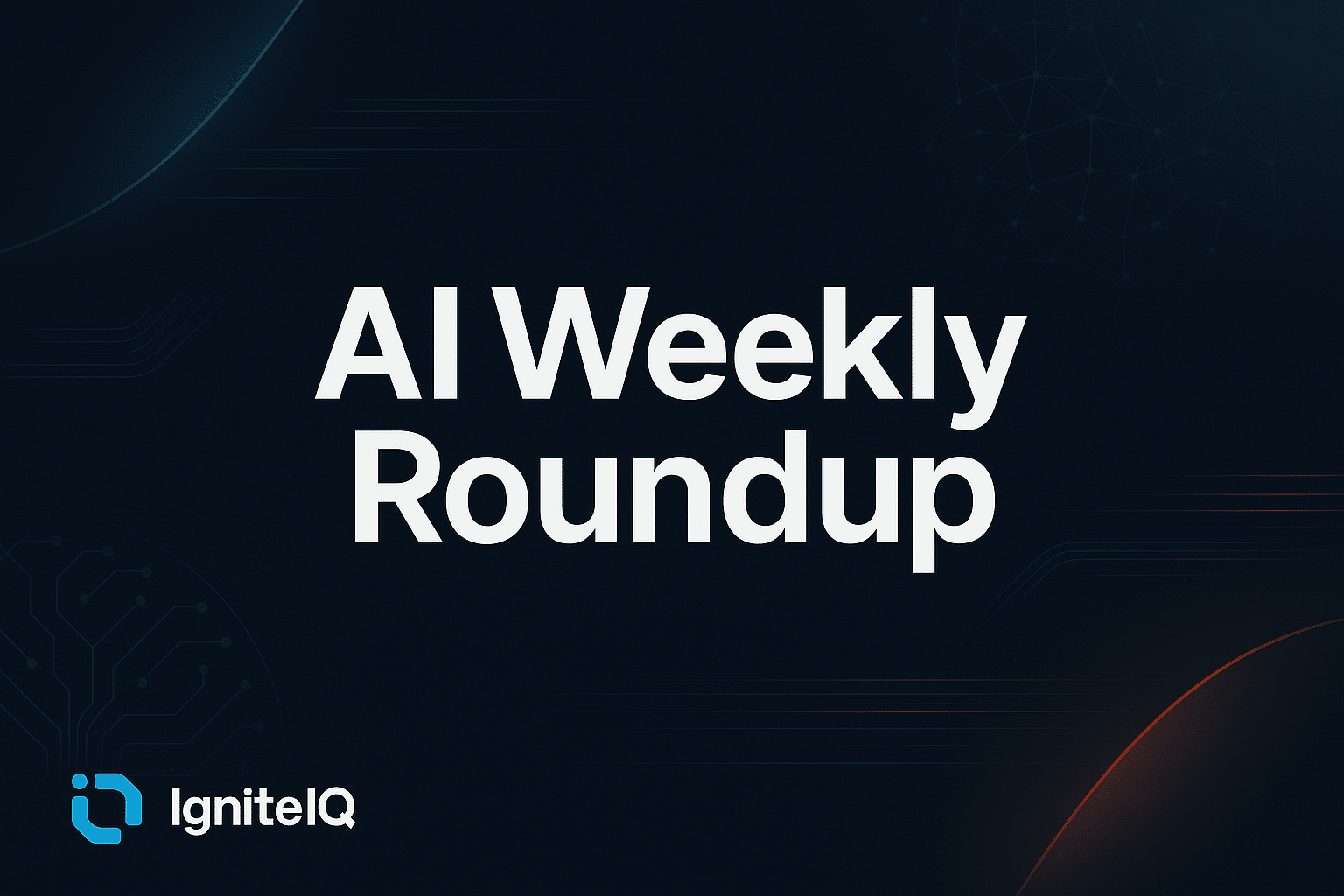The week’s most strategic AI developments, decoded for marketing leaders
AI moved beyond iterative updates this week-delivering transformative agents, integrated commerce, data controls, and new creative infrastructure. Here’s your executive-level briefing:
What CMOs Should Do This Week
- Assign your team to test ChatGPT Agents for recurring tasks (e.g., campaign briefs, weekly reports)
- Prototype a branded AI persona for Messenger or WhatsApp
- Evaluate your site’s AI crawler permissions (Cloudflare, robots.txt)
- Audit all ecommerce flows for chat-to-checkout potential
- Align upcoming campaigns with predictive analytics for creative validation
Model & Infrastructure Updates
What This Section Covers: Advances in foundational models, agent capabilities, persistent memory, and ecosystem-level AI upgrades
Quick Takeaways:
ChatGPT Agents introduce persistent, autonomous AI teammates
Agent memory enables deeper personalization and strategic alignment
Gemini 2 Ultra will transform document-based collaboration and productivity
OpenAI debuts ChatGPT Agents
OpenAI launched one of its most ambitious capabilities yet-ChatGPT Agents. These are customizable, persistent bots that can browse the web, interact with APIs, manage files, and even retain context over time. Positioned as your own AI teammate, Agents can now handle multi-step tasks that previously required human oversight. From pulling performance reports to drafting campaign copy or organizing a project sprint, these tools go beyond response generation-they’re autonomous executors.
This changes the game for marketing operations. The idea of having an agent that not only remembers previous instructions but can adapt and iterate means the end of repetitive creative and operational churn. For CMOs, it opens the door to delegating a significant chunk of mid-level work to AI-not just for speed, but for strategic consistency. If your team isn’t already exploring which workflows can be offloaded, you’re risking being outpaced by competitors who are.
Assistant API with Memory goes live
OpenAI also rolled out an API that lets Agents “remember” context and previous interactions. This means your AI copywriter, ad optimizer, or customer support bot no longer starts from scratch with every prompt-it remembers tone, brand voice, customer history, and campaign rules.
This capability brings us into the era of persistent, brand-aligned AI. With memory, agents become extensions of your internal team. They can adapt to long-term strategies and customer lifecycle stages. For marketers, this means higher personalization, fewer errors, and smarter optimization loops. Imagine an AI that remembers every A/B test and evolves its recommendations accordingly.
Google teases Gemini 2 Ultra
Google is gearing up to release Gemini 2 Ultra, its next-generation flagship model promising superior reasoning, longer context windows, and tight integration across Google Workspace. The emphasis is on full multimodal input-text, images, charts-processed natively inside Docs, Sheets, and Gmail.
This signals that productivity and marketing workflows will increasingly shift inside AI-native ecosystems. CMOs should expect a future where ad planning, content briefs, and creative reviews happen inside AI-augmented documents. Marketers should be exploring how Gemini’s tools can support cross-functional workflows, data storytelling, and even live-collaboration with AI.
User-Centric Use Cases & Features
Quick Takeaways:
Shopify is bringing full ecommerce checkout into AI conversations
Conversational commerce is now a realistic funnel model
Human safeguards remain critical for trust and compliance
Chat-to-cart: Shopify + ChatGPT checkout
Retail TouchPoints confirmed Shopify is working directly with OpenAI to enable native checkout within ChatGPT. This integration will let users complete purchases entirely within a conversation-transforming ChatGPT from a research or support channel into a full transactional flow.
Why does this matter? Because it redefines the funnel. Marketers no longer have to fight for conversion across fragmented pages-purchase, upsell, and post-sale engagement can now live inside one continuous chat. This reduces friction, improves attribution, and opens the door to rich conversational commerce experiences. It’s a chance to meet consumers not where you want them-but where they already are.
Shopify safeguards agent checkout
While enabling transactional AI, Shopify also added a critical guardrail: agents can’t finalize a purchase without human approval. This ensures compliance with ecommerce and consumer protection laws and limits liability for brands.
For marketing leaders, this is an opportunity-not a constraint. It preserves trust while still delivering automation. Brands can now build “intelligent concierges” that guide shoppers through the journey, tee up purchase options, and personalize offerings-while the final click remains in human hands.
AI Governance, Visibility & Access
What This Section Covers: How AI crawlers, access models, and content policies are changing how brands manage visibility and control
Quick Takeaways:
AI crawler access is no longer guaranteed-visibility must be managed
Persistent AI personas will shape future brand engagement
Predictive analytics are merging with generative workflows
Cloudflare locks down AI crawlers
Cloudflare, which powers over 20% of the internet, announced that it will now block AI scrapers by default. Additionally, it’s piloting a pay-to-crawl model-forcing AI tools like Perplexity, Claude, and others to either pay for access or negotiate content licenses.
This is a seismic shift. It essentially turns discoverability into a contract. For marketers, it means you can no longer assume AI engines will index and present your content. You’ll need to choose a bot access strategy-open, closed, or licensed-and treat AI visibility the same way you treat paid search or partner distribution.
Meta tests brand AI personas
Meta is now testing persistent branded AI personas on Instagram and Messenger. These bots aren’t just customer service agents-they represent the tone, values, and behavior of the brand in real-time conversation.
The shift here is from static brand voice to living, responsive engagement. These AI personas will drive community, conversion, and content creation in new ways. CMOs should immediately consider how their brand tone translates into a chat-based, real-time presence-and what guardrails are needed to keep that consistent.
Adobe adds AI-native predictive analytics
Adobe’s latest dashboard fuses generative design with predictive analytics. Teams can now generate creative assets and instantly view projected campaign results-based on customer segments, formats, and channels.
This bridges the gap between intuition and insight. Creative marketers can now test iterations with clear performance projections, turning subjective calls into data-backed decisions. CMOs should press for tighter integration between design and analytics workflows, enabling faster iteration and stronger creative impact.
Strategic Trends & Behavioral Shifts
What This Section Covers: Emerging behaviors, adoption data, and directional shifts shaping the AI-powered marketing landscape
Quick Takeaways:
3D and immersive agent content is gaining traction in ecommerce
Generative AI is mainstream in performance advertising
Creative and content teams are rapidly adopting AI in workflows
E-commerce boosts via 3D agent content
Nvidia and Apple are both ramping up infrastructure for branded 3D assets generated by agents. These allow product photos, explainer videos, and social content to be created on demand-with depth, interactivity, and personalization.
This trend could redefine how consumers explore products. Marketing teams should explore 3D asset generation tools to level up ecommerce UX and repurpose content across immersive channels.
Small ads trend: 86% of advertisers using GenAI
New IAB data shows 86% of advertisers are actively using or piloting generative AI to produce video ad content. This shift indicates that performance teams are no longer waiting-they’re embedding AI into their daily production cycles.
The key takeaway? If you’re not already benchmarking your AI-produced ads against traditional creatives, you may be underutilizing your team’s output capacity.
Action Framework for Marketing Leaders
What This Section Covers: Tactical moves, workflow ideas, and takeaways you can implement this week
| Insight | Why It Matters | What To Do Today |
|---|---|---|
| ChatGPT Agents land | AI just moved from chat to action | Identify three workflows to automate-reporting, calendars, outreach |
| Agent memory enables loyalty | Bots can now learn brand style and past interactions | Pilot branded agents with persistent memory using OpenAI APIs |
| Commerce in conversation | Chat-to-cart reduces friction dramatically | Prototype Shopify checkout inside ChatGPT |
| Bot control is becoming paid | AI visibility is now a licensing or pay-to-access channel | Choose crawl strategy-block, free, or paid AI access |
| Persona bots arrive | Brand voice will now live in conversational agents | Define guardrails and UX/UI templates for your branded AI persona |
| Predictive analytics go live | Creative teams gain forecasting insights via tools like Adobe | Test predictive forecasting in next campaign planning cycle |
| 3D + AI creative is scaling | Rich visual experiences and agent-driven content offer new engagement vectors | Explore NVIDIA Omniverse for immersive campaign pilots |
| GenAI ads reach critical mass | Video becomes AI-driven at scale, rebalancing performance expectations | Audit your CTV and video partners for AI capacity or integration |
Next Wave Watchlist
Claude + Siri integration may reshape voice search UX
YouTube’s rumored AI co-watching assistant (internal testing)
Qodo’s agent scripting reaching non-dev audiences
Grok 5 in closed eval-xAI says it could outplan Gemini and Claude
Final Word
This week’s developments show AI is moving beyond ideation and experimentation-it’s now automating, personalizing, selling, and predicting in real-time. For CMOs, this isn’t just about keeping up-it’s about re-architecting how teams operate, how campaigns are built, and how customers are engaged. Pick one area-agents, commerce, content, or analytics-and get moving. Because those who move slow won’t just fall behind. They’ll be forgotten.
Let’s build smarter.
Matt Lawler

Weekly AI Update | August 18th, 2025
Insights / AI Weekly Roundup: August 18–24, 2025 Agents mature, hardware gets smarter, and trust becomes the moat In a week where AI agents went

Weekly AI Update | August 13th, 2025
Insights / This Week in AI Insights, updates, and actions from the frontlines of AI strategy AI continues to push boundaries, and this week the

Weekly AI Update | August 6th, 2025
Insights / This Week in AI Agentic AI Starts With Data Hygiene AI is accelerating again. This week brought rangy model updates, regulatory shifts, and

